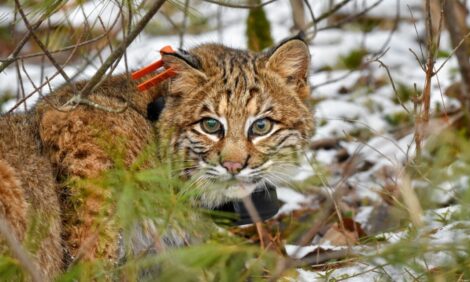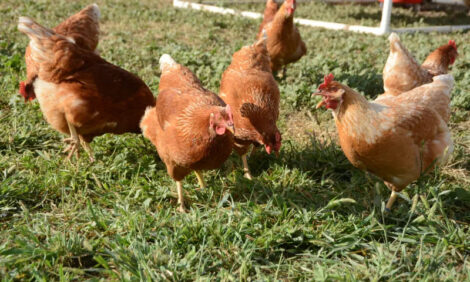



Salmonella in Animal Feedingstuffs and Other Products Associated with the Animal By-Products Regulations
Of the almost 45,000 tests carried out on these materials in Great Britain last year, fewer than one per cent were positive for Salmonella, according to the 2011 edition of 'Salmonella in Livestock Production in GB', an annual publication from the Veterinary Laboratories Agency.The total number of animal feedingstuffs and ingredients tested during
2011 (47,311 tests) increased by 5.2 per cent compared to 2010 (44,982 tests).
There were increases in the number of tests performed on
several product types. These included oilseed meals and products for
feedingstuffs use, non-oil seed meal vegetable products, pig extrusions,
pig and poultry meals, poultry extrusions and minerals/other which
increased by 12.6 per cent, 10.5 per cent, 36.3 per cent, 68.3 per cent, 27.6 per cent and 29.1 per cent, respectively,
compared with 2010.
There were, however, falls in the number of tests
performed on several types of product including processed animal protein
at a GB processing premises, GB and imported processed animal protein
arriving for feedingstuffs use, ruminant concentrates, and protein
concentrates. Tests on these products fell by 5.4 per cent, 3.0 per cent, 11.1 per cent and
26.7 per cent, respectively, compared with 2010.
The overall number of tests
positive increased from 407 to 420, although the mean percentage of total
tests positive was the same in 2011 as in 2010 (0.9 per cent).
On 23 March 2011, the Animal By-Products (Enforcement) (England)
Regulations No.2011/881 came into force. Similar legislation applied in
the rest of the UK. The Regulations include some derogations from the EU
rules. These Regulations enforce the directly applicable requirements of
the EU Animal By-Products Regulation 1069/2009 and EU Implementing
Regulation 142/2001, which entered into force on 4 March 2011. It is
possible that the changes in regulations may have influenced the number
of tests carried out on some types of animal by-products.
There were 28 isolations of regulated Salmonella serovars in 2011
compared to 19 isolations in 2010. These were two reports of S.
Enteritidis (both from feedingstuffs), 15 reports of S. Infantis (14 from
feedingstuffs and one from an avian blood product intended for pet food),
five reports of S. Typhimurium (four from feedingstuffs and one from
rendering plant material), four reports of S. Virchow (all from feedingstuffs)
and two reports of monophasic S. Typhimurium (one from feedingstuffs
and one from rendering plant material).
This was compared with no
reports of S. Enteritidis, four reports of S. Infantis, 10 reports of S.
Typhimurium, no reports of S. Virchow and five reports of monophasic S.
Typhimurium during 2010.
Contamination of imported brewer’s yeast with S. Infantis and other serovars was subject to investigation by the Food Standards Agency
during the year.
The total number of isolations of Salmonella reported from ruminant, pig,
poultry and horse compound feed, and from feedingstuff ingredients are
listed in various tables.
There were increases in the number of isolations in 2011 compared with
2010 from the following feedingstuffs: barley, brewer's yeast, compost,
cooked pulses, linseed, maize, meat and tallow, mill environment, mixed
oil seeds, rendering plant material, sunflower and 'other' (not specified).
There were decreases in isolations in 2011 compared with 2010 from the
following feedingstuffs: rape, soya and unspecified material.
Isolations from fishmeal and palm kernel remained the same in 2011
compared with 2010.
The most commonly reported serovar from feedingstuffs during 2011 was
S. Senftenberg with 47 reports, which was an increase (23.7 per cent) in the
number of reports of this serovar compared with 2010 (38 reports). The
majority of reports of S. Senftenberg were from sunflower seed (11
reports), compound feeds (nine reports) and cooked pulses (five reports).
S. Montevideo was the second most commonly reported serovar from
feedingstuffs and animal by-products with 30 reports during 2011
compared with four during 2010; these were mostly from meat and tallow
(11 reports) and sunflower seed (seven reports).
The number of batches of domestically produced animal protein that were
officially tested during 2011 (423 batches) increased by 3.9 per cent compared to
2010 (407 batches). The number of positives increased from two (0.5 per cent) in
2010 to seven (1.7 per cent) in 2011. Although the percentage of
positive batches tested increased from 0.5 per cent in 2010 to 1.7 per cent in 2011, this
was still lower than in 2003, 2005, and 2007-2009 inclusive.
The serovars reported during 2011 were S. Orion var 34+, S. Senftenberg,
S. Tennessee, S. Infantis and S. Schwarzengrund.
There were no batches of imported protein tested for Salmonella during
2011, which may be due to reduced importation, compared with 52 tested
in 2010.
Further Reading
| - | You can view the full report by clicking here. |
September 2012








